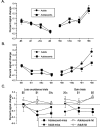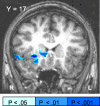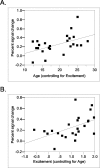Incentive-elicited brain activation in adolescents: similarities and differences from young adults
- PMID: 14985419
- PMCID: PMC6730402
- DOI: 10.1523/JNEUROSCI.4862-03.2004
Incentive-elicited brain activation in adolescents: similarities and differences from young adults
Abstract
Brain motivational circuitry in human adolescence is poorly characterized. One theory holds that risky behavior in adolescence results in part from a relatively overactive ventral striatal (VS) motivational circuit that readily energizes approach toward salient appetitive cues. However, other evidence fosters a theory that this circuit is developmentally underactive, in which adolescents approach more robust incentives (such as risk taking or drug experimentation) to recruit this circuitry. To help resolve this, we compared brain activation in 12 adolescents (12-17 years of age) and 12 young adults (22-28 years of age) while they anticipated the opportunity to respond to obtain monetary gains as well as to avoid monetary losses. In both age groups, anticipation of potential gain activated portions of the VS, right insula, dorsal thalamus, and dorsal midbrain, where the magnitude of VS activation was sensitive to gain amount. Notification of gain outcomes (in contrast with missed gains) activated the mesial frontal cortex (mFC). Across all subjects, signal increase in the right nucleus accumbens during anticipation of responding for large gains independently correlated with both age and self-rated excitement about the high gain cue. In direct comparison, adolescents evidenced less recruitment of the right VS and right-extended amygdala while anticipating responding for gains (in contrast with anticipation of nongains) compared with young adults. However, brain activation after gain outcomes did not appreciably differ between age groups. These results suggest that adolescents selectively show reduced recruitment of motivational but not consummatory components of reward-directed behavior.
Figures




References
-
- Achenbach TM (1991) Manual for the child behavior checklist/4-18 and 1991 profile. Burlington, VT: University of Vermont.
-
- Andersen SL, Gazzara RA (1993) The ontogeny of apomorphine-induced alterations of neostriatal dopamine release: effects on spontaneous release. J Neurochem 61: 2247-2255. - PubMed
-
- Arnett J (1992) Reckless behavior in adolescence: a developmental perspective. Dev Rev 12: 391-409.
-
- Bechara A, Damasio H (2002) Decision-making and addiction (part I): impaired activation of somatic states in substance dependent individuals when pondering decisions with negative future consequences. Neuropsychologia 40: 1675-1689. - PubMed
-
- Blum K, Braverman ER, Holder JM, Lubar JF, Monastra VJ, Miller D, Lubar JO, Chen TJ, Comings DE (2000) Reward deficiency syndrome: a biogenetic model for the diagnosis and treatment of impulsive, addictive, and compulsive behaviors. J Psychoactive Drugs 32[Suppl i-iv]: 1-112. - PubMed
Publication types
MeSH terms
Grants and funding
LinkOut - more resources
Full Text Sources
